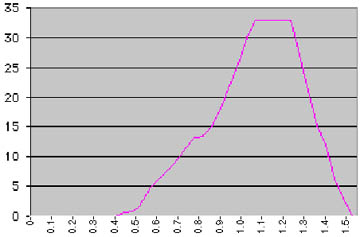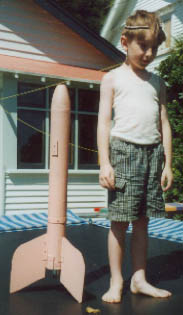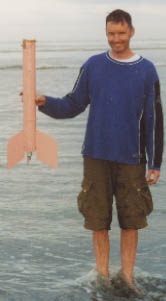Experimental Rocketry
Home | Graphic Design | Music | Experimental Rocketry | Walter Wall Corp. | Email me
Some people go to hobby stores, buy model rockets, join a club and then launch them. This requires a certain amount of common sense, because rockets are potentially very dangerous. This is called Model Rocketry, and can be diverting for a while, but it is not for me.
No - I want to build powerful rockets using nothing more than what I can find in my kitchen, garden shed and garage. I want to brew my own fuel, stuff it into my own motors, and fire my own rockets into the stratosphere. This other form of rocketry is called Amateur Experimental Rocketry. A handful of people are doing it around the world. If you don't want to kill yourself, or passers by, or blow up your kitchen it requires alot more than a certain amount of common sense.
Richard Nakka is the king of this discipline, and the leading group involved would be the Norwegian Amateur Experimental Rocketry Association. (NEAR).
In a more modest scale I have managed to develop my own moderately powerful motor, and launch one rocket. To get there I have destroyed three prototype motors and had two misfires on the launch pad - oh yes, and I (nor any passers by) have been maimed in the process.
The Motor

It is a G-class motor, and it is a reusable version of Chuck Knight's single-use PVC motor. It uses KN/Dextrose fuel, has an aluminium casing, steel nozzle and end closure. If you don't understand this terminology, visit Richard Nakka's site.
|
|
I tested it on this rather crude looking rig, and found it to be rather more powerful than Chuck's prediction. The rocket pushes down on the kitchen scales via a 3:1 lever. I videoed the test firing and was thus able to get a reading off the scale every 0.04 seconds. |
|
Thrust |
|
Note: the flat bit at 33 pounds is where the scale topped out. Because it stayed up there for a good 0.3 seconds I am assuming it is not undamped overswing of the needle.
The Rocket
|
|
Here is the rocket, ready to go, beside my son Linus. It was 3" in diameter and weighed 2.2lbs with fuel. It is painted the same colour as the Royal Hawaian Hotel. Some might say that pink is an unsuitable colour for a rocket. Chuck says his PVC G motor should propel a 2", 2 lb rocket to 1000 ft. |
|
|
Sorry, no launch photo. Here I am after wading 100 metres through surf to retrieve it. It flew in a huge semicircle, about 300 ft high. |
Rocket #2
Simpler and lighter, and
built of PVC tube. Picture to come. I cast a rather rough looking
grain in less than ideal surroundings at our beach house. I loaded
the motor, went down to the beach early next morning with two very
keen nephews in tow, and, two igniters later, it didn't
light!
We had fun taking the fuel grain out later and setting it
off on the beach - with due safety precautions, of
course.
Rocket 2 awaits our next visit to the beach.
Cheap Fuel!
Instead of paying $10 (NZ) for a 1lb jar of stump remover at the garden shop, I have just bought 40 lb for $40 from a farm supplies depot. Damn, I guess I'll have to use it now.
Motors...
My faithful G motor blew
out its case during the first run of my rocket
car. I will make a
new case - this time using a separate inhibitor and case liner.
Meanwhile I have made a quick PVC motor to Johnny
Dyer's design, and
it tested perfectly. I can't find an equivalent of Water Putty for
the nozzle, so I used a steel nozzle, drilled and filed out of a
large bolt (expansion ratio around 3:1). I will reuse the
nozzle.
This was a promising experiment. I might jump up to the next size
pipe and make a double-grain "I" class motor...



